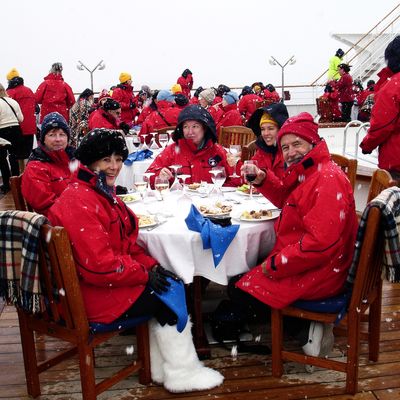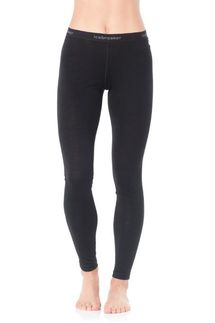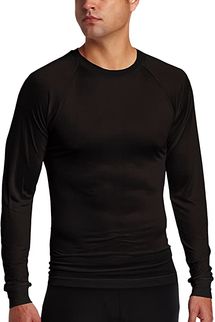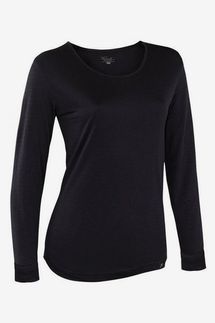
After a brief stint of allowing indoor dining with reduced capacity, New York City has once again limited restaurants to outside service, takeout, and delivery in response to rising COVID-19 rates. While eating alfresco was lovely during the summer, now that it’s cold out, it’s a bit of a different story — one that involves more preparation and much warmer clothes. You could go the extreme route and put on a wearable sleeping bag, like Strategist writer Kayla Levy, or for something a little less noticeable, take a hint from winter athletes, who rely on base layers to stay warm even in extreme weather.
Ira Rosh, divisional merchandise manager at Paragon Sports, says these close-fitting tops and bottoms worn underneath your outfit are designed to trap warm air near your body and wick away any moisture that might accumulate if you sweat. Rosh says to look for wool, silk, or synthetic base layers. Unlike cotton, these materials pull moisture away from your skin to keep you from feeling cold and damp. “We semi-joke that ‘cotton kills’ because if you get wet it’s not a good plan,” Rosh says. Read on for a breakdown of each materials’ benefits, along with pieces recommended by Rosh and other outdoors experts. Then toss them on under a warm sweater and pants, top it off with your warmest jacket, and continue supporting those local restaurants (comfortably).
Best wool base layers
“Wool is going to offer a greater warmth factor overall,” Rosh says, so if you’re someone who gets cold easily or you plan on being outside in freezing weather, consider going with wool base layers. And you shouldn’t worry about it feeling scratchy on your skin, Rosh assures us: “Most wool base layer products are merino, which has a much higher tactile comfort-feel. It’s not your grandma’s itchy wool sweater anymore.” He says most brands offer different weight wool pieces. They’re usually measured in grams per square meter (or GSM), with heavier ones being thicker and warmer than lighter ones. Icebreaker, one of Rosh’s favorite brands, sells wool base layers in weights from 150 GSM (which the brand calls “ultralight”) to a “midweight” 260. You’ll sometimes see wool base layers or socks labeled as “expedition weight,” which Rosh says is typically the brand’s thickest and warmest material. The 200 GSM tops and bottoms pictured here are light and thin enough to fit under your clothes while still feeling plenty warm. Although your personal cold tolerance, activity level, and the weather will determine which weight is right for you.
Like Icebreaker, Smartwool is another leader in the merino-wool base-layer space. Rosh mentioned it, as have many other outdoorsy types we’ve spoken to in the past. In a Strategist story on the best base layers for athletic pursuits, Andy Docken, director of the Aspen Mountain Ski School in Aspen, Colorado, recommended Smartwool base-layer tops because, along with being warm and cozy, they can stay odor-free for a few wears in between washes. REI category merchandising manager Shelly Wilkinson also raved about Smartwool leggings when we went in search of the best long underwear for women. “Merino 250 is the warmest base-layer option that Smartwool offers,” she says. “It helps maintain comfort whether the climate is warm, cold, or in between.
These mesh wool base layers might look a little strange, but costume designer Stacey Berman learned they were the best option for staying warm while working on a film in the Arctic Circle. She was tipped off to them by her Norwegian colleagues, who have lots of experience with the cold. “The science behind net layers is pretty simple: The open weave of mesh lets your body heat escape as a vapor, instead of sticking close to your body and turning into sweat,” Berman writes. “Sweat is the enemy of warmth. With mesh, the heat you produce gets trapped in by the next layer you’re wearing, whether that’s classic long underwear or your clothes.”
Best silk base layers
Silk isn’t going to be as warm as wool, but it is the thinnest and lightest-weight base-layer option, making it a good choice for comfortable, all-day wear under your street clothes. A bulky, ill-fitting base layer may not matter much when you’re wearing it under baggy snow pants, but it’ll be much less comfortable under a pair of jeans. Rosh says to choose silk “if you want to feel like you’re wearing almost nothing underneath.” He recommends Terramar, an activewear brand, for lightweight silk pieces that are also machine washable. Dogsled racer Maria Gaffney wears silk base layers from Patagonia (unfortunately the company no longer makes them), and she agrees that they feel the best against the skin. “The silk-weight base layer is nice because it’s smooth and nonirritating,” she says. “I like a wool base layer for my second layer. Wool is wonderful for warmth and nonstinky-ness, but my skin is sensitive to it sometimes.”
Best synthetic base layers
According to Rosh, synthetic base layers wick moisture away the fastest, which explains why they’re a top pick among outdoor athletes working up a sweat. Typical synthetic materials include polyester, spandex, and elastane, and these layers come in a wide range of weights for different temperatures. Alyssa Ravasio, founder of the camping booking site Hipcamp, loves this mid-weight polyester top because it feels soft against the skin and also, since it’s designed for outdoor exercise, keeps you dry. “It’s perfect to wear under your clothes at dinner or out on a hike,” she says. “It’s super lightweight, but traps the heat without being uncomfortable.” Daniel Kenney, the public-relations and communications manager at upstate New York’s Hunter Mountain and an avid skier and snowboarder, once told us the base layers from Patagonia’s Capilene collection “hit the sweet spot of weight, breathability, and wicking performance.”
For full body warmth, Ravasio recommends this top and bottom set (that’s actually made from recycled bottles) from Rwandan brand Impano. “This set is like a second skin to wear under winter outerwear,” she says.
Nicholas Wicks Moreau, a blacksmith at Wicks Forge in Maine, knows about staying warm, since his workshop is in an uninsulated barn and he often has to keep the doors open for ventilation. Most of the time he wears these microfiber bottoms, which, he says, “breath really well, so I don’t get sweaty while I’m working or if it warms up some.” They feature a metallic lining that reflects your body heat back to you, like the shiny silver blankets you’ll sometimes see runners wearing after cold-weather races.
On the coldest days, Moreau opts for these extra-warm bottoms, which he likes for their “blankety/fleece material.” Moreau tells us that he’s been wearing these base-layer bottoms and the Columbia tights above since his undergrad days at McGill University in Montreal, where, he says, it’s “negative 40 degrees sometimes in the winter.”
The Strategist is designed to surface the most useful, expert recommendations for things to buy across the vast e-commerce landscape. Some of our latest conquests include the best acne treatments, rolling luggage, pillows for side sleepers, natural anxiety remedies, and bath towels. We update links when possible, but note that deals can expire and all prices are subject to change.




























